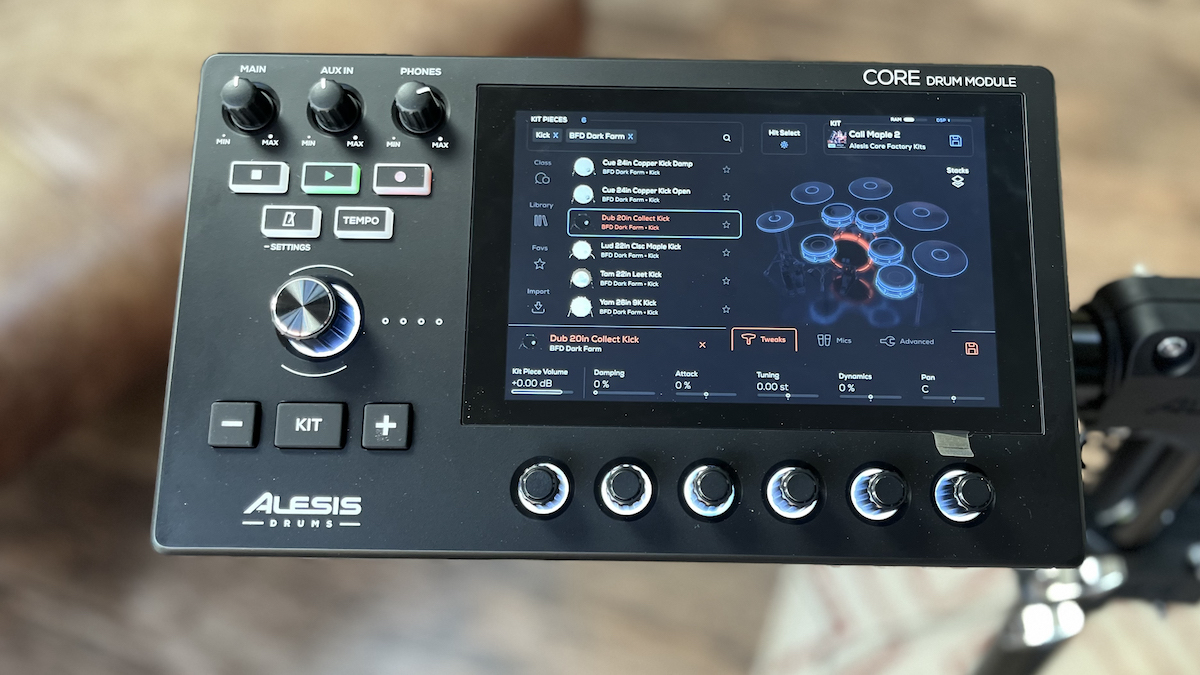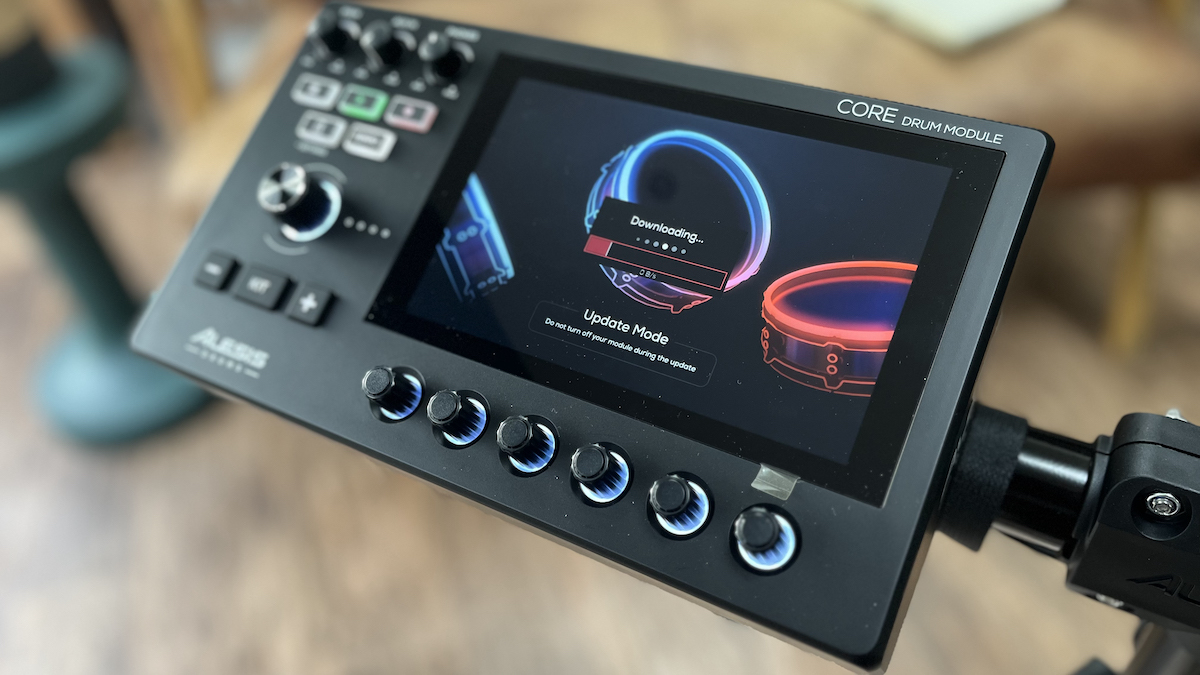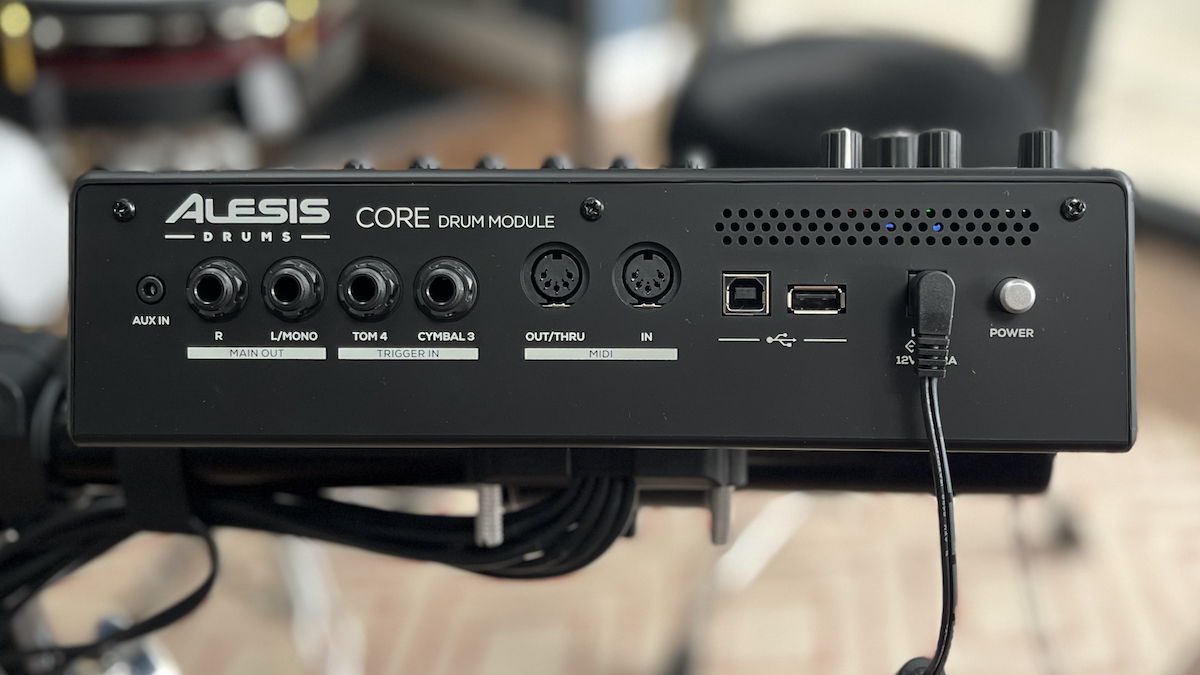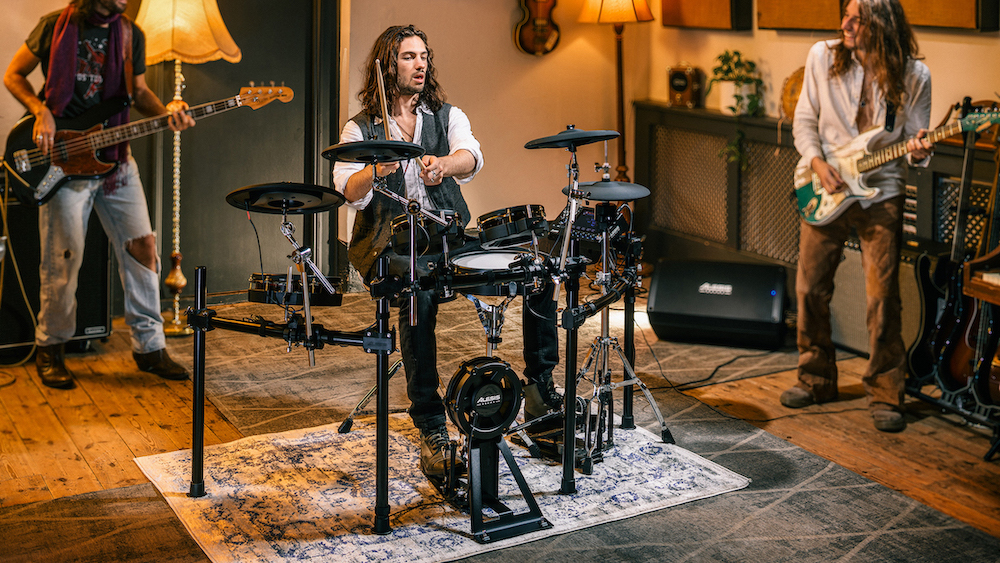MusicRadar Verdict
With the introduction of the Strata Core, it looks like Alesis’ biggest competitor to the Strata Prime is currently coming from itself. There’s very little not to be impressed with here, from the extremely playable sounds to the slick and easy user interface. You’ll save a pretty substantial chunk of change with the Core, too.
Pros
- +
Excellent BFD-derived, multi-sampled drum sounds in a module
- +
Colour touchscreen
- +
WiFi/Bluetooth connectivity
- +
Many of the most important Strata Prime features are present
- +
Very attractive price point
- +
Space-saving footprint
Cons
- -
Pad sizes are small, but playable
- -
No audio interface
- -
Simplified audio routing and cable snake makes it less stage-ready
MusicRadar's got your back
Earlier this year, Alesis dropped a bombshell with the Strata Prime: an electronic drum kit that seemingly came from nowhere and instantly wowed me with its performance. I say seemingly, because on the surface it was a quiet plot unveiled to rapturous applause.
However, if you’ve been paying attention, the Strata Prime was actually more of a logical progression for the brand. You see, in 2020, Alesis’ parent company, InMusic snapped up the BFD virtual drum library, which had been somewhat left floundering without much development by previous owner ROLI. What does a hardware company need one of the leading drum software plugins for? To power its hardware, of course.
That’s exactly what happened, and I was impressed. The Strata Prime module features a soundset powered by BFD 3, delivering what we drummers keep asking for: a drum module with multi-sampled sounds that will convince us to unplug the MIDI connections to our laptops, making using an electronic drum set a more viable proposition when it comes to the three-legged stool of practice, live performance and recording.
But, as we’re about to find out, the Strata Prime was only the beginning of the story. Having one flagship product is all well and good, but Alesis has long been known as the brand that delivers at multiple price points. Make a great e-kit and that’s exactly what you have, expand with another and you’ve got a series. Clearly, the folk at Alesis don’t put much value into getting a Good Night’s Sleep, because while the world is still asking each other on forums about the Strata Prime, they’ve only gone and ruddy released the next, more affordable chapter in the Strata saga: meet the Alesis Strata Core.
Alesis Strata Core review: What is it?


A quick glance at the Strata Core’s spec sheet confirms that what I’m presented with here is a case of ‘Honey, I Shrunk The Kit’. Starting with the overall configuration, there’s a five-piece, all-mesh drum pad setup: 12-inch snare (with an acoustic snare stand included), 8-inch bass drum pad (a tower, rather than the Prime’s real-shell 18-inch bass drum), 2x 8-inch rack tom pads and a 10-inch floor tom pad. These follow the same design and visuals as the Strata Prime pads, with the deep red oyster-ish wrap offset by black rim bumpers and gold tension rods. It looks classy, and feels every bit as quality as the Strata Prime, just smaller.
The drum pads are accompanied by a set of Alesis ARC (Alesis Rotatable Cymbal) 14-inch ride cymbal, two 12-inch crashes and a 12-inch hi-hat pad. Each cymbal is 360-degree playable, which is nerd-speak for saying ‘it doesn’t matter where you hit it’. They’re all triple-zone and choke-able, so all the common cymbal articulations (crash, bow and bell) are achievable. The hi-hat pad is a single-piece design, so there’s no top/bottom moving parts, but it does mount to an acoustic hi-hat stand (not included). It also makes use of Alesis’ magnetic-sensing technology to transition between open/closed pedal detection. Once again, these are the same series which ship with the Strata Prime, only smaller.





Finally, there’s the Strata Core module, it shares the same colour touchscreen concept as the Strata Prime, with a reduced real estate of 7.1-inches of tapping space. The insides have been stripped back a bit too with the factory sample content reduced from 40 gigabytes to a how-will-we-possibly-survive 25GB of BFD3 samples. This being a more consumer-level product, hardware connectivity is reduced too. Gone are the discrete trigger inputs and direct outputs of the Prime, replaced with a DB25 cable snake (hiss) for connecting the triggers, and master left/right outputs for sending everything to a PA system for amplification. Also present at the back of the module are two additional trigger inputs for a tom and cymbal, a mini-jack auxiliary input, 5-pin MIDI in/out, and USB memory/host slots. Here is where I find one of the first big features to be removed entirely: the USB socket is for MIDI only, not audio. So, if you do want to use this with a computer for audio, you’ll need a separate audio interface.
To the front, there are dual headphone outputs, which share the same control but make it a great feature if you’re using this kit for lessons where more than one person needs to hear what’s being played.
The Strata Core also inherits a couple of other connectivity features that I love about the Strata Prime, too - WiFi (for hassle-free downloading of firmware updates) and Bluetooth (for wireless audio streaming into your headphones while playing, as well as a wireless MIDI connection).
Alesis Strata Core review: Sounds & playability

I’ve said it before, and I’ll say it again now - the least fun part of getting your hands on an electronic drum set is the initial build. The Strata Core arrived in one fairly sizable box containing everything, including the steel rack and clamps. Assembly will take you around an hour, perhaps a little longer if you haven’t done it before. Grab a coffee, put on a podcast and make sure there’s nobody offended by bad language as you curse the metal tubes and clamps, and it’ll pass in no time.
That is, until you connect the pads. A cable snake is most definitely an efficient solution to delivering multiple connections in an affordable way, but if the sight of looping, tangled cables bothers you, now is the time to pay attention to the bag of velcro cable-ties that Alesis provides, because you’ll need them to try and get everything even approaching tidy. Of course, this isn’t a criticism of Alesis or the Strata Core specifically, as running the cables around the stand is the accepted way of plugging everything in for many brands. However, I do wish there was a neater option.
With the kit set up and plugged in, I hooked the Strata Core module up to my WiFi connection. This is the first time you’ll notice the touchscreen, which makes inputting our WiFi password a doddle: no scrolling, no awkward backspaces, just tap it in like you would on a keyboard. Once connected, the Core informs me that it would appreciate a firmware update. I oblige by jabbing the screen, and the module does the rest. About 25 minutes later, it’s downloaded, installed and re-booted.
Everything responds with pretty much the same authenticity as the Strata Prime, with buzz rolls and ghost notes playing and sounding natural across the kit
Now it’s time to play. The Strata Core’s sound engine comprises 370 kit pieces (a drum or cymbal, for example). These have been created using multiple microphone positions: close/overheads/room to capture the realism of an acoustic drum kit being played in a top-notch acoustic environment. As well as this, each kit piece is recorded by a real human drummer hitting the instrument at different volume levels, so, when you hit a drum pad softly, it plays back the sound that was recorded with a soft hit. Hit it hard and you get the harder-hit sample, rather than the same sound being played back at different volumes.
This is done in detail, with multiple dynamic layers for every kit piece, so the Strata Core contains over 144,000 sound files to make up those 370 drums/cymbals. These kit pieces are arranged into 75 factory preset kits, and are interchangeable. This means you can swap any part of any kit, as well as combining sounds to create ‘Stacks’. These layered sounds allow for blending of up to four multi-layered sounds on one pad, so you can design your own hybrid drum sounds, combining sonic elements like snare drum body from one drum, while embellishing the attack and crack by blending in another sound. When you’re done, there’s user memory available for you to mix-and-match the factory sounds into your own custom kits.
Often, when a product is derived from a more expensive one, the limitations are noticeable from the off. But with the Strata Core, you get sounds plucked from the same pool as the Prime: Alesis Core Acoustic, BFD Dark Farm, Alesis Core Electronic and BFD Percussion. There’s just fewer of them to choose from.

The result is that everything responds with pretty much the same authenticity as the Strata Prime, with buzz rolls and ghost notes playing and sounding natural across the kit. Some of my favourite kits from the Strata Prime (Binary Cleanse, That Alesis DnB) are also present. The user interface is very similar too, with most operations being within reach of the kit screen. As with the Prime, the Core’s touchscreen and visual approach makes this very intuitive, albeit slightly more cramped with the reduced screen size.
If you want to change a drum or cymbal, you can either hit the pad to select it, or tap its on-screen counterpart, from here you can tap (or scroll using the rotary control if you’d prefer) to your chosen selection, tap again and you’re done. There are six rotary encoders beneath the screen if you need to make adjustments finer than your digits will allow, and overall the combination of both touchscreen and analogue-style control means that you’ll be navigating your way around the Core in no time.
One big feature that was missing at launch with the Strata Prime was Bluetooth Audio (this came in a post-launch firmware update), but I’m pleased to report that not only is Bluetooth available straight out of the box here, it works seamlessly too!
It would be a little unreasonable of me to expect the Strata Core to bring design improvements over its more expensive sibling, and while the Strata Core includes everything I love about the Strata Prime (the impressive sounds, the wireless connectivity, touchscreen and more), it also inherits one of my big gripes. That lies in the snare drum pad, which, while perfectly responsive thanks to the tensionable mesh heads, features the same two-zone performance of the Prime. This gives you a centre head zone, a rim zone, and the facility to play them together for rimshot sounds. However, the detection for playing a crosstick isn’t intelligent. You have to tell the Core that you want the snare’s rim to either create a rim click (a stick striking the rim only) or a cross-stick sound. With the latter, playing your hand on the head as you would with an acoustic drum while you play a crosstick sound is redundant. So in order to play a cross-stick, you either strike the rim of the pad while holding the stick in your regular grip (which isn’t authentic), or lay the stick so that the butt and tip bridge across the top of the rim (better, but still not entirely natural). It’s not a dealbreaker, but I’d love to see an improvement in this area for a future update.
With the Strata Core, it’s a compromise that includes a more home-friendly kit size and ultimately a significantly more affordable kit
Elsewhere, the triggering is faultless. Alesis’ magnetic hi-hat sensor/controller works very well with the reduced-size of the 12-inch pad. It’s fast and responds to my foot position straight out of the box, and this only improves once I’ve calibrated it using the easy, two-step setup function. You can recalibrate whenever you like too, so if you change stands or simply want a little more or less play on the pedal, it’ll be sorted in about 30 seconds.
I was worried that I’d miss the larger format 18-inch bass drum, and find the introduction of a tower a bit more flimsy. But, there’s plenty of space for a double pedal, and the tower stayed put on my rug throughout my time with the Strata Core. Visually, it’s not as impressive, but the space-saving, rock solid performance more than makes up for this.
And that brings me to my main observation with the Strata Core: pad size. Acoustic players love the familiarity of ‘real-size’ pads and cymbals, but the upscaling of electronic kits to match (or get near to) our acoustic sizes is a fairly new trend. With the Strata Core, it’s a compromise that includes a more home-friendly kit size and ultimately a significantly more affordable kit. It’s most noticeable on the rack toms, which would feel a little more realistic if they were 10-inch, with a 12-inch floor tom pad to match the snare’s diameter.
The 14-inch ride cymbal is comfortable to play, and in reality the most likely candidate for you to be playing bell sounds on. I found that the smaller size did mean that I was more prone to hitting the stand’s wingnut in this position, but it’s by no means an unreasonable size. If you’re used to playing larger diameter electronic cymbals, it might take a bit of time to adjust, and of course, the larger ARC cymbals are available as a post-purchase upgrade if you’d rather have more realistic sizes. But I should punctuate this with my opinion that the included sizes are absolutely workable, and in-line with what I’d expect from a kit at this price.
Alesis Strata Core review: Final verdict

Earlier in the year, I predicted that the Alesis Strata Prime would net the prize of MusicRadar’s favourite electronic drum kit of 2024. Since then, we’ve seen the introduction of Roland’s V71, which sees the Japanese giant flexing its foray into multi-sampled drum sounds within a module. Now, with the introduction of the Strata Core, it looks like Alesis’ biggest competitor to the Strata Prime is currently coming from itself. There’s very little not to be impressed with here, from the extremely playable sounds to the slick and easy user interface.
You’ll save a pretty substantial chunk of change with the Core, if you’re willing to give up the audio interface (which is a fairly affordable purchase) and some of the authentic pad sizing. Similarly, the reduced audio routing puts this closer to the spare room than the stage. To some, that’s a compromise, to others, it’s actually exactly what’s required. After all, why include features that aren’t going to be used, or add drums and footprint that aren’t as viable at home? What you get here is the essence of Alesis’ flagship electronic drum set, with all the great 2024 features, minus the stuff that (let’s face it) is likely to be ‘nice-to-have’ rather than essential. The answer is in the name: Core indeed.
Alesis Strata Core review: Hands-on demos
Sweetwater
Andertons
Alesis
Alesis Strata Core review: Specifications
- Module: Alesis Strata Core
- Pads: 8” bass drum tower (single-zone), 12” snare drum (dual-zone), 2x 8” rack toms, 10” floor tom
- Cymbals: ARC cymbal pads - 12” hi-hat (one-piece w/magnetic sensor), 2x 12” crashes, 14” ride cymbal (all three-zone)
- Hardware: Alesis steel rack w/ABS clamps, cymbal boom arms, snare stand, module clamp
- Features: 7.1” touchscreen, 25GB samples, 75 preset kits, Bluetooth MIDI and audio, USB MIDI interface
- Contact: Alesis

I'm a freelance member of the MusicRadar team, specialising in drum news, interviews and reviews. I formerly edited Rhythm and Total Guitar here in the UK and have been playing drums for more than 25 years (my arms are very tired). When I'm not working on the site, I can be found on my electronic kit at home, or gigging and depping in function bands and the odd original project.
“I used everything I knew about music”: How Green Day exceeded expectations with their most ambitious song
YouTube just added AI tools that makes musicians, library music and video editors redundant
“Every one of them said yes without hesitation": Hank Marvin and Roger Taylor have just remade a '60s classic for charity













